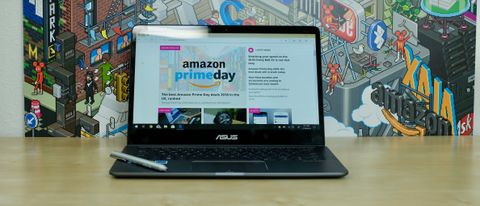TechRadar Verdict
The Asus ZenBook Flip 14 is the quintessential 2-in-1 laptop for students who need a reliable computer, but that fingerprint reader needs to be moved.
Pros
- +
Lightweight
- +
Soild performer
- +
Well designed
Cons
- -
Bad fingerprint reader placement
- -
Inconsistent Windows Ink experience
Why you can trust TechRadar
With back to school season just kicking off, both traditional and 2-in-1 laptops are in high demand. Students need a computer that’s reliable, has adequate battery life and is powerful enough to get through a random Photoshop task.
The new Asus ZenBook Flip 14 walks that line, as do the Samsung Notebook 9 Pro and Lenovo Yoga 920.
Heck, Asus has a few laptops that would fit the bill as well. However, the ZenBook Flip 14 sets itself apart from the pack, thanks to its premium design and beefy internals. Boasting Intel’s latest generation Core i7 processor and Nvidia’s MX150 graphics, the Flip 14 is more than capable of meeting a student’s needs.
Well, most of them.
Here is the Asus ZenBook Flip 14 configuration sent to TechRadar for review:
CPU: 1.8GHz Intel Core i7-8550U (quad-core, 8MB cache, up to 4.0GHz with Turbo Boost)
Graphics: Nvidia GeForce MX150 (2GB GDDR5 RAM); Intel UHD Graphics 620
RAM: 16GB DDR4 (2,133MHz)
Screen: 14-inch FHD (1,920 x 1,080) touchscreen wide-angle
Storage: 512GB SSD (PCIE Gen3x4)
Ports: 1 x USB-C 3.1, 2 x USB 3.0 Type-A, 1 x HDMI, 1 x 3.5mm audio jack, 1 x SD card reader
Connectivity: 802.11 ac Wi-Fi (2x2), Bluetooth 4.2
Camera: HD webcam
Weight: 3.3 pounds (1.49kg)
Size: 12.9 x 8.9 x 0.5-inches (327 x 226 x 13.9 mm; W x D x H)
Price and availability
We’ve tested a souped-up version of the ZenBook Flip 14, which has an Intel Core i7-8550U processor, Nvidia GeForce MX150 GPU and Intel UDH Graphics 620 for less intensive tasks. It’s loaded with 16GB of memory, and 512GB of storage. All of that powers the 14-inch touchscreen that’s held to the body of the Flip 14 by two, 360-degree hinges.
In the US, this configuration runs $1,299 (about £990, AU$1,758). If you’re OK with dropping down to an i5 and cutting storage and memory in half, the price drops to $849 (about £644, AU$1,148).
In Australia, the only confirmation we could find is the Flip 14 with an 8th generation Intel Core i5, 8GB of memory and 512GB of storage for AU$1,799.
UK customers have to forgo the 14-inch model altogether. Instead, Asus offers either a ZenBook Flip S (incredibly thin and portable) or a Flip model with a 15.6-inch display.
The Flip 14 is priced in line with the competition. Take the Samsung Notebook 9 Pro as an example. The only model that the company makes comes with an i7-7500U, 15-inch FHD display, AMD Radeon 540 graphics, and 16GB of memory for the same $1,299 (about £1,000, AU$1,720) as the Flip 14. Lenovo’s Yoga 920, a device more closely matched with the Flip 14 on paper is priced slightly higher, at $1,549/£1,349.







Design
There’s a lot to like about the build quality of the ZenBook Flip 14. From the metal housing to its sturdy hinges, the Flip feels like a 2-in-1 that can take the occasional drop in a backpack or knocked off a desk without any damage.
Despite its sturdy exterior that measures 12.9 x 8.9 x 0.5 inches (327 x 226 x 13.9 mm; W x D x H), the Flip weighs a respectable 3.3 pounds (1.49kg). It’s not the lightest 2-in-1, with the Yoga 920 being slightly lighter at 3 pounds, but it’s light enough to carry around all day without being noticeable.
The right side of the housing is where you’ll find a microSD card reader, a USB-C 3.1 port, 3.5mm audio jack, a USB 3.0 Type-A port and a full-sized HDMI port. On the left side is a lone USB 3.0 Type-A port, a volume rocker, and the power key. The volume and power keys are close enough and feel enough alike that we often mix them up, pressing the power button when we intend to adjust the volume and vice versa.
The backlit keyboard uses chiclet keys, requiring little pressure to activate each key. The keys are evenly spaced, and we needed little adjustment before we were typing at normal speed with very few typos.
The touchpad is smooth the to touch unless you get near the top-right corner. There’s a slight divot that feels out of place. The divot is a fingerprint reader that works with Windows Hello to unlock the laptop without a password.
The 14-inch FHD display is surrounded by somewhat narrow bezels on the sides, with an HD webcam centered along the top. The colors are a slightly muted on the screen, but it’s not a deal breaker. Our only issue with the screen is that it’s not particularly bright.

Leave the touchpad alone
We need to rant for a second. Asus, please: stop putting the fingerprint sensor in the touchpad? It breaks up an otherwise stellar input method on the Flip, along with any other model using the same placement.
We understand Asus wanting to streamline the design, and with the power button on the side of the housing, there’s nowhere else to hide the fingerprint reader. Regardless, there has to be another way.
- 1
- 2
Current page: Introduction, price and design
Next Page Performance, battery life, features and verdict
Scientists inch closer to holy grail of memory breakthrough — producing tech that combines NAND and RAM features could be much cheaper to produce and consume far less power

Google adds biometric verification to Play Store to keep your in-store wallet safe

Quordle today – hints and answers for Wednesday, April 17 (game #814)
